Investigations of high-level radioactive materials and nuclear fuel
The Waste Safety Testing Facility (WASTEF)
◎ Purpose of the facility
The operation of WASTEF was initiated for the purpose of safety tests on the storage and disposal of high-level radioactive wastes arising from the reprocessing of spent fuel, and the originally planned activities were completed in the fiscal year of 1996.
Subsequently, the hot cells and instruments have been reused for post-irradiation examinations and hot examinations; e.g., hot environmental tests and transuranium (TRU) handling tests have been conducted to provide technical support to various JAEA research programs.
◎ Completion year of construction
1981
◎ Features of the facility
Material tests and various post-irradiation examinations can be conducted. In particular, hot examination is conducted on various materials under an alpha atmosphere as the cell scale.
◎ Equipment
The facility was designed for the usage of nuclear fuel materials and radioisotopes include the following:
| βγ Concrete cells | 3 |
| αγ Concrete cells | 2 |
| Lead cell | 1 |
| Glove boxes | 6 |
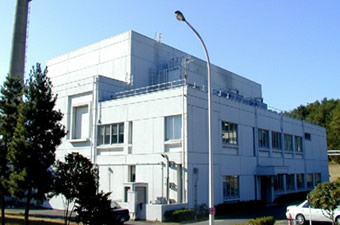
A view of the facility
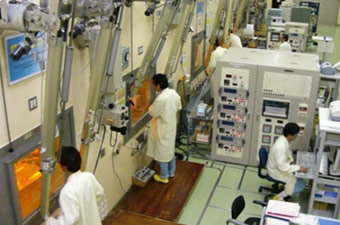
Operating room
◎ Main Examination Items
| Concrete No. 1 cell | Sample storage, Fuel cladding fracture toughness tests, Tensile and compression tests |
| Concrete No. 2 cell | Material testing (Slow strain rate tensile (SSRT)/Uniaxial constant load tests), Autoclave tests |
| Concrete No. 3 cell | Test specimen preparation, Dissolution tests, Heating surface corrosion tests, Cladding tube SSRT |
| Concrete No. 4 cell | Leaching test, Size measurement, Heating surface corrosion tests |
| Concrete No. 5 cell | Small-scale molten-solidified production fabrication, TRU compound manufacture examination |
| Lead cell | X-ray diffraction examination |
| Glove box | Chemical treatment, Analysis, Composition analysis, Leaching test |
| Others | Thermodiffusion coefficient measurement, Specific-heat-capacity measurement, Radioactivity measurement, Ultimate analysis, Transmission electron microscope (TEM) observation, Focused ion beam (FIB) machining equipment, Oxide film surface potential measurement examination |
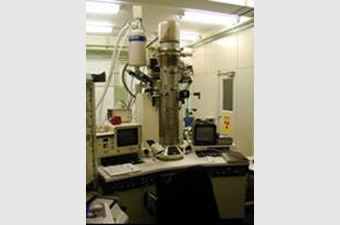
Field Emission-type Transmission Electron Microscope
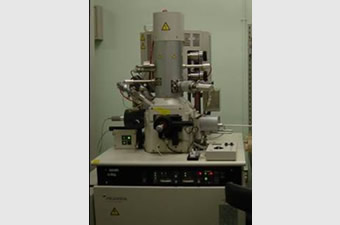
Focused Ion Beam System
The laboratory building No. 4
◎ Purpose of the facility
Various investigations using nuclear fuel materials and radioisotopes are conducted in this facility.
◎ Completion year of construction
1981 (West building), 1991 (East building)
◎ Features of the facility
Several types of analyses have been conducted using the following apparatuses:
- ・Inductively coupled plasma mass spectrometer (ICP-MS)
- ・Inductively coupled plasma atomic emission spectrometer (ICP-AES)
- ・Ion chromatography (IC)
- ・Liquid scintillation counter (LSC)
- ・Gamma-ray spectrometer (Ge semiconductor detector)
Several types of analyses are also being conducted for the post-accident investigation of the Tokyo Electric Power Company’s Fukushima Daiichi Nuclear Power Plant accident.
◎ Equipment
The facility was designed for the usage of small amounts of nuclear fuel materials and radioisotopes include the following:
| Laboratory rooms | 111 |
| Hoods | 98 |
| Glove boxes | 20 |
| Lead cells | 2 |
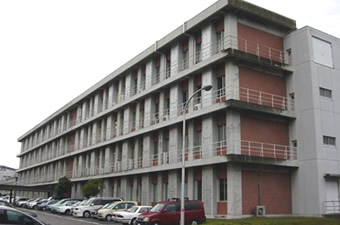
A view of the facility
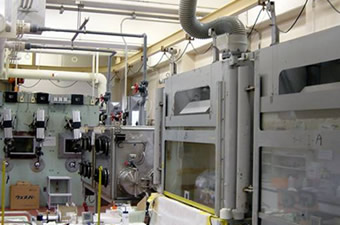
Hoods
The experiment building No. 2 for JRR-3
◎ Purpose of the facility
This facility is designated for analytical chemistry research of samples irradiated in research reactors, and radiochemical analyses related to the operational management of research reactors.
◎ Completion year of construction
1988
◎ Equipment
The facility was designed for the usage of small amounts of nuclear fuel materials and radioisotopes include the following:
| Laboratory rooms | 9 |
| Hoods | 8 |
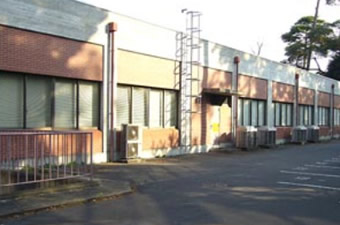
A view of the facility
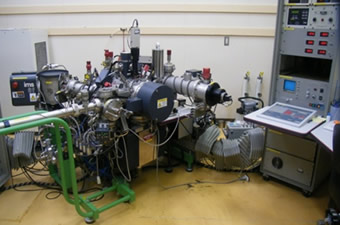
Secondary Ion Mass Spectrometer







